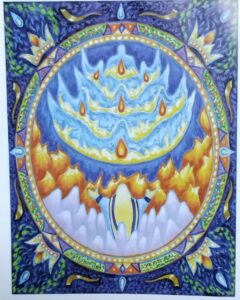בס”ד
By Rabbi Moshe Goodman, Kollel Ohr Shlomo, Hebron
The Symbol of The Holy Presence

This painting has seven lights, a clear reference to the Menora, considered by our Sages to be a symbol of the Holy Presence. Before this image is a man wrapped with a talis praying as can be seen with his outstretched hands, implying prayer before the Holy Presence. We see flames of fire surrounding the one in prayer, as prayer is like a fire, an intense motion of fervor that rises to Heaven. This man is praying amidst other people seen as purple figures. This implies that the power of prayer is found especially through the collective as found in a minyan and/or also praying for the collective. This idea is found in this parsha when Moshe Rabeinu prays intensely and extensively for the Jewish People, even sacrificing his own name for the sake of the People – “and if You don not save them [Israel] then erase me from your book.” Indeed, the culmination of atonement for Israel for the Sin of the Calf occurred on Yom Kippur when Moshe Rabeinu received the second tablets. This day of atonement has been kept ever since. This idea of Yom Kippur can be seen in this painting through the shofars, a symbol of repentance. Also the crowns hint to the theme of kingship on this day [as is the case all the ten days of repentance].
There are interesting combinations of water and fire here, such as the seven fire-lights combined with blue water. Also there are flames at the center of the circle, with drops of water surrounding this circle. Water is considered kindness while fire is considered judgment. The internal spiritual energy called “or pnimi” is associated with judgment, while the encircling spiritual energy called “or makif” is associated to kindness, according to the Kabbalah. Nevertheless, some aspects of this kindness do protrude into the center as we saw in the seven lights here. The relationship between Torah and prayer has been compared to the relationship between “or pnimi” and “or makif,” since the meaning of Torah study is more readibly “absorbed within” one’s consciousness [this being called “hafnama”], while prayer one usually does not know how their prayer has had influence, and as such its value seems to be “beyond/circling beyond grasp.” Yom Kippur has great emphasis on both these themes, since Yom Kippur has the most prayers than any other day of the year and also it is the day of the giving of the Second Tablets of the Torah.
Hebron also encompasses these themes since Hebron is considered synonymous with Torah in the Zohar (p. Shlach), and the Lubavitcher Rebbe said that all prayers arise to Heaven via Hebron!



